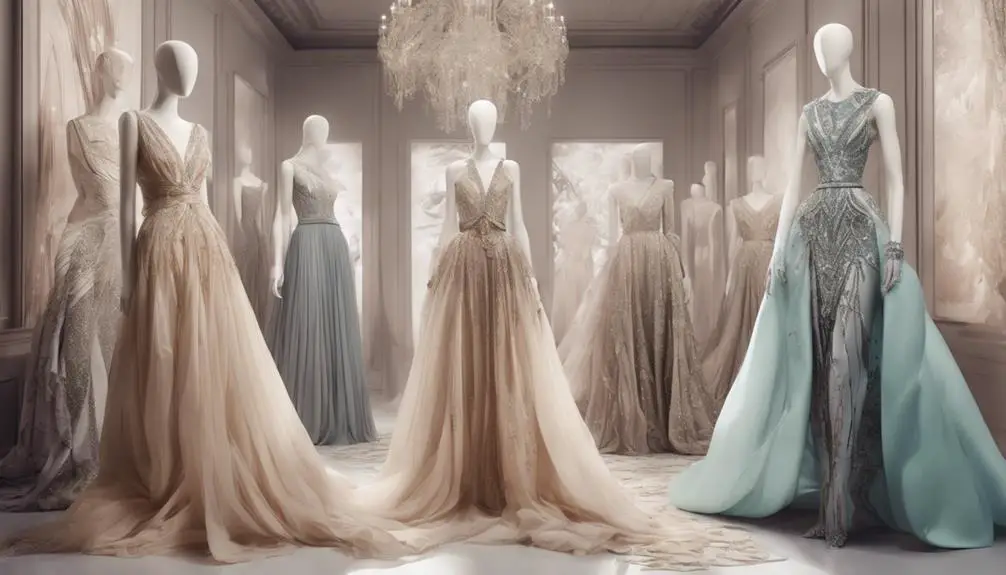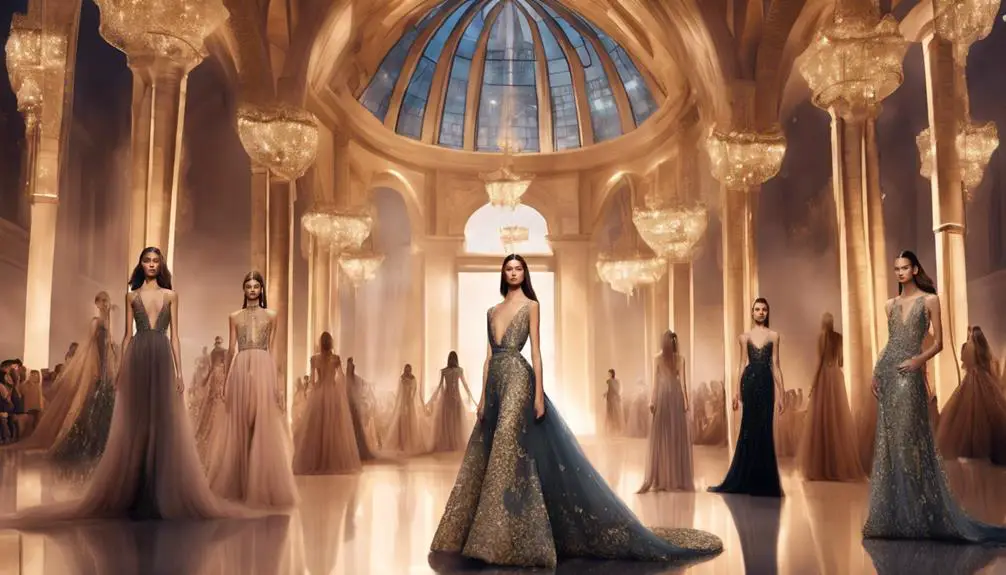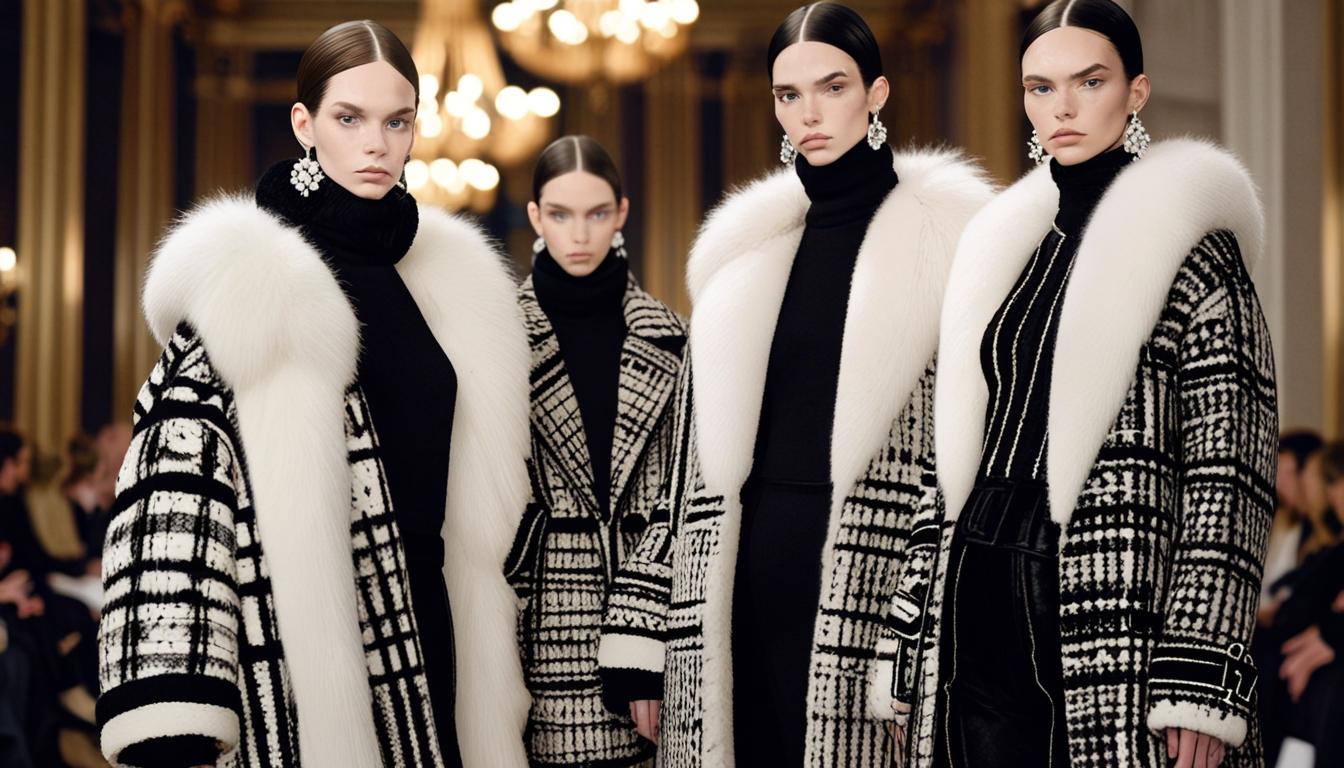Elie Saab's founding story is a fascinating journey that starts in 1964 in Lebanon, where his love for design bloomed early. By age nine, he was using his mother's sewing supplies to create stunning pieces for his sisters. At just 18, he opened his first couture atelier in Beirut. His big break came in 1997 when he showcased his collection in Rome. This led to global recognition, dressing celebrities like Halle Berry and royals such as Queen Rania. Saab's opulent designs blend Lebanese heritage with modern fashion, leaving a lasting mark on the industry. There's so much more to discover about his influence!
Early Life and Inspirations

Elie Saab's journey into the world of fashion began in the vibrant setting of Damour, Lebanon, where he was born in 1964. From a young age, you can see that his passion for design was evident. At just nine years old, he started experimenting with his mother's sewing supplies, creating unique pieces that would lay the groundwork for his future as a renowned designer.
By the time he was a teenager, he was already gaining local recognition for his early creations, which consisted of stunning dresses he crafted for his sisters.
In 1982, at the age of 18, Saab took a significant leap by opening his first couture atelier in Beirut. Managing a team of over a dozen employees at such a young age demonstrates his extraordinary talent and determination.
His work during these formative years showcased a seamless blend of Western and Middle Eastern design elements. This fusion not only set him apart in the competitive fashion scene but also laid a foundation for his future success.
Saab's brief move to Paris at 17 further influenced his design aesthetic, exposing him to the world of high fashion. The experiences he gained there enriched his understanding of couture, allowing him to draw inspiration from diverse sources.
As you explore Elie Saab's early life and inspirations, you'll discover how his roots in Lebanon and his creative experimentation shaped the iconic designer he'd become.
Rise to International Fame
The ascent of Elie Saab to international fame began in 1997 when he revealed his first collection in Rome, a moment that marked his entrance onto the global fashion stage.
As a Lebanese designer, Saab captured attention with his exquisite craftsmanship and innovative designs. Just a year later, in 1998, he launched his ready-to-wear line in Milan, drawing notable figures like Princess Stephanie of Monaco to his fashion show. This event greatly boosted his visibility and reputation.
A pivotal point in Saab's career came in 1999 when he designed a stunning gown for Queen Rania of Jordan during her coronation. This moment not only showcased his talent but also solidified his status in the elite circles of the fashion world.
However, it was the 2002 Oscars that truly catapulted him to stardom. When Halle Berry graced the red carpet in a custom Elie Saab gown, the media frenzy that followed brought him massive international recognition.
Iconic Designs and Collaborations

Known for his opulent detailing and luxurious fabrics, Elie Saab's iconic designs reflect a seamless blend of 1950s Hollywood glamour and Lebanese heritage. His creations captivate, celebrating femininity and elegance, making them a favorite in the fashion industry.
Saab gained international acclaim when Halle Berry wore his stunning burgundy gown at the 2002 Oscars, marking a historic moment as the first Lebanese designer to dress an Oscar winner. This significant collaboration not only elevated Saab's profile but also showcased the beauty of his artistry.
Elie Saab frequently collaborates with high-profile celebrities and royals, such as Queen Rania of Jordan and Crown Princess Victoria of Sweden. These partnerships further enhance his brand visibility, allowing his iconic designs to grace red carpets and royal events worldwide.
His ready-to-wear collections are equally impressive, combining modern sophistication with the timeless elegance he's known for.
Beyond clothing, Saab has expanded his influence through projects like serving as a judge on "Project Runway: Middle East." Here, he mentored emerging designers, sharing his expertise and passion for fashion.
His fragrance line, starting with "Elie Saab Le Parfum," captures the essence of light and femininity, adding another layer to his luxurious brand.
Through these iconic designs and collaborations, Elie Saab hasn't only shaped his brand but also left an indelible mark on the fashion industry, embodying the glamour and richness of both his Lebanese roots and the golden era of Hollywood.
Expansion and Business Growth
Expansion and business growth have been pivotal in establishing Elie Saab as a global fashion icon. From the moment he opened his five-storey boutique and workshop in 2005, Elie Saab began transforming his brand. The launch of his first ready-to-wear collection in Paris in 2006 was a game-changer, making high fashion accessible to a broader audience. By 2010, Saab's designs graced the red carpets, dressing an impressive 102 celebrities at global events, which solidified his presence internationally.
Here are some key milestones in Elie Saab's expansion journey:
- Flagship Store: In 2010, he opened a flagship store in Dubai, marking a significant step in his global presence.
- Fragrance Launch: The introduction of "Le Parfum" in 2011 became an instant hit, ranking as the top seller in 15 countries, showcasing his brand's diversification.
- Asian Market Entry: By 2012, Saab continued his expansion by opening his first store in Asia, alongside new locations in Mexico and Geneva.
- Boutique Growth: Each new boutique not only enhanced his operational capacity but also improved brand visibility, attracting fashion enthusiasts worldwide.
Through these strategic moves, Elie Saab has transformed his label into a household name, continually evolving while retaining the elegance and sophistication that defines his work.
The combination of ready-to-wear offerings and a strong fragrance line has guaranteed that his brand remains relevant and desirable across global markets.
Cultural Impact and Legacy

Elie Saab's designs have greatly influenced the global perception of Lebanese fashion, blending traditional craftsmanship with contemporary aesthetics. His work showcases the beauty of Lebanese heritage while incorporating modern aesthetics, allowing the world to appreciate the rich culture of Lebanon.
With an atelier in Beirut employing around 250 skilled artisans, Saab preserves intricate embroidery techniques that have been passed down through generations.
The House of Elie Saab has dressed notable figures, including Queen Rania of Jordan and celebrities like Halle Berry, elevating the cultural representation of the Middle East in haute couture. These iconic moments not only highlight Lebanese fashion but also reflect the resilience of a country rich in history and creativity.
Saab's collections often draw inspiration from Lebanon's urban architecture and historic landmarks, further emphasizing his role as a cultural ambassador.
Beyond fashion, Elie Saab's commitment to philanthropy shines through his collaborations with UNICEF, focusing on children's initiatives in Beirut. This dedication to giving back enhances Lebanon's image globally, showing that creativity can drive positive change.
His legacy isn't just about beautiful gowns; it's about shining a light on Lebanese culture, resilience, and the ability to thrive against adversity.
Through his work, Elie Saab has created a lasting impact, inspiring future generations of designers and promoting a deeper understanding of Lebanese identity in a global context.
His designs are more than just clothing; they're a celebration of culture, heritage, and the human spirit.





Rattling excellent visual appeal on this web site, I’d rate it 10 10.